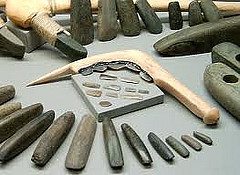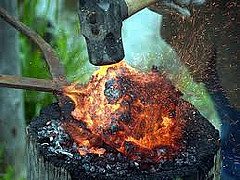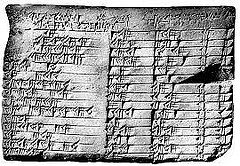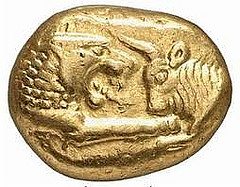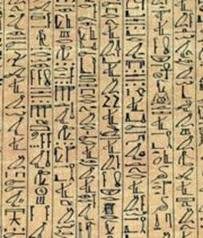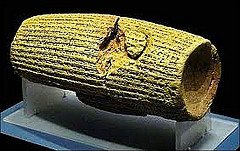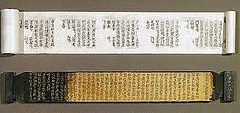From the mists of evolution and ancient prehistory, the struggles and creativity of homo sapiens sapiens – human beings – trying to make good for themselves in this often hostile world, there came certain revolutionary developments that led in a steady progression to the primary foundations of civilization and ‘modern’ society. Thus ultimately to the “State Of The World” as we find it today.
There are many ways to list and rank those developments over time to describe particular elements of the human condition. Unfortunately those all too often end up being histories of war – including religious wars – and the violent struggles of cultures to seize or secure advantages for their own generations during circumscribed slices of time. Though warfare has led to many important technological developments through the ages, the benefits have always been transitory in the course of humanity’s cultural evolution – too particular to describe the “big picture.”
These are the great socio-economic inventions of our species. These great developments have almost always occurred contemporaneously in populations widely separated from each other. Sometimes they spread by means of trade, sometimes they developed independently. The apparent oddity of concurrent independent development follows the pattern of physical evolution itself, and intriguingly suggests that the socio-cultural evolution of our species may be as ‘natural’ as the process of physical evolution.
1. Agriculture and Animal Husbandry
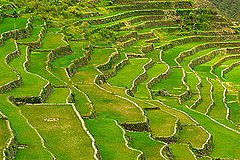
Humans made the transition from hunter-gatherer societies to the domestication of livestock and farming in the Neolithic era between 13,000 and 10,000 years ago, simultaneously occurring in various parts of the world. The developments allowed specialization and a division of labor, the establishment of permanent settlements and complex populous societies we call “civilizations.”
Both food and fiber crops were grown by early farmers, including grains like rice, barley and teosinte (early corn), legumes (peas and beans), potatoes, squash, fruit and oil crops, cotton and hemp. In choosing from among the best plant’s seeds for planting in following seasons or best vines/trees for careful tending, the steady development of ever better crops through artificial selection began.
A geology-based invention that should be also listed here is the
development and use of Terrace Farming in mountainous regions of the world. The terracing of steep slopes in order to create flat areas on which to grow crops was first practiced by the Incas in the Andes mountains of South America prior to 1000, b.c.e., and within a few hundred years also appeared in Asia from the Himalayas to the islands of the Pacific rim and Polynesia. This allowed for populations in confined and mountainous regions to increase lands under cultivation dramatically. Canals on the upslope edges of terraces collected rainwater and allowed productive irrigation of the crops grown on the flat surfaces, and periodic flooding for the growing of rice.
2. Tools and Trade In Tool-Making Materials
Humans had always been tool-makers, developing the sharp instruments for hunting and cutting wood, preserving and sewing skins, etc. very early in our history. The most prized raw materials for making sharp implements were chert and flint stone and obsidian – a volcanic glass. These substances were found only in certain regions, and were the very first items of trade between separated populations.
With the development of agriculture these substances as well as others were turned into tools designed for the purpose of tilling land and cultivating crops, and for harvesting.
3. Trade In Goods
Prehistoric societies had developed trade and trade routes for the purpose of obtaining sometimes rare raw materials, primarily the obsidian, chert and flint from which hunting weapons and sharp implements could be made. With agriculture and animal husbandry the variety of tools that could be traded, as well as the domesticated animals and crop seeds that could be exchanged expanded greatly. Often the currency for trades were specialty items that particular tribes and cultures produced that other cultures found desirable. These could be anything from artworks and jewelry to finished goods like baskets and pottery, textiles of hemp, linen or wool, and the skins/furs of animals.
In many parts of the world trade routes developed first along waterways and coastal areas, where goods could be transported by ship. Soon large trading centers were established that drew buyers and sellers from far regions and helped to spread the cultural amenities different cultures had developed and perfected. A merchant class quickly arose to service the trade markets as early as ~3,500 b.c.e. in both the old and new worlds, and ships designed and built for the purpose were plying the Danube, Nile, Black Sea, and Mediterranean seaports that long ago. Similar trading routes were established as well in Asia and the Americas.
As the trade routes expanded the slow pace of travel led to traders seeking commodities of high value but low volume that were basically non-perishable. Gems, salt, gold, spices, fine textiles and precious ornaments fit the bill. Between 6,000 and 4,000 b.c.e. the extensive copper deposits on Cyprus initiated and expanded the trade in functional metals – copper and tin, which graduated to the production of the much harder metal alloy of bronze, and the Bronze Age was born.
4. Metallurgy
Primitive humans could find gold in nuggets on the ground or in stream beds in its pure form, and the metal was always highly prized for its ornamental value. Gold is not, however, very useful for anything else.
Copper was a more serviceable metal that was easily exuded from rocks in an enclosed fire. It is much harder than gold or silver and was quickly put to use as material for knives and axes and sickles that lasted much longer than stone or bone implements. Copper began to be commercially smelted around 3,000 b.c.e., and was soon being poured molten into prepared molds. This is the art of metallurgy. Mining technology was developed in conjunction with metallurgy, and the copper mines of Sinai along with their huge wind-funneled smelters (circa ~3,800 b.c.e.) soon spread the technology to the Levant and Egypt.
It was at Ur in Mesopotamia that the first smelting of bronze – an alloy of copper and tin – first took place around 2,800 b.c.e. From there it spread to the Indus valley in India and westward through Europe from about 2,000 b.c.e., eastward into China by 1,500 b.c.e. This is the Bronze Age. Also around 1,500 b.c.e. the Hittites of Anatolia discovered how to smelt iron, possibly by originally smelting the iron content of a meteorite. Iron was found abundant in surface ores and as the value of the metal was recognized, the practice spread widely. Soon it was discovered that iron reheated with charcoal in the furnace produced an even harder metal known as steel.
5. Numbers and Numerical Systems
The development of trade, first locally, then expanding to regional and even international trade, led to the need for ways to keep track of the goods and exchanges taking place. Bones and other artifacts bearing marks have been found in many places where prehistoric humans lived, and are believed to be tally totems using “natural numbers” accounting for keeping track of days, lunar cycles and records of quantities. Such tallies have no concept of place value for large amounts (such as the decimal system), but do represent the development of the abstract concept of accounting. The trick was to develop systems that could be understood across the far regions of expanding trade routes and tokens.
The first known place value systems arose in Mesopotamia, specifically Uruk period Sumer, circa 4,000 b.c.e. There were a dozen different numerical accounting systems in use according to protocuneiform artifacts recovered, for tallying different commodities, weights and volumes. By 3,400 b.c.e. a base 60 system was developed and in use in the region. The first known base 10 system was in place in Egypt by 3,100 b.c.e. We are still using the base 10 system today as well as the zero, but the Mesopotamian base 60 system gifted us with the division of hours into 60 minutes and circles into 360 degrees.
Later development in various cultures brought us negative numbers, rational numbers, irrational numbers, transcendental numbers, infinities/infinitesimals, complex numbers and primes. Which is probably not all that impressive to the average American middle school student, but does represent abstract mathematical developments that led to some rather spectacular deeds of science and engineering.
6. Money
Barter was the original medium of exchange among humans for goods and services. The problem was that there was no set value and people often disagreed about what things were worth. And while direct commodity exchanges worked a bit better, carrying around amounts of salt, tea, tobacco or seeds wasn’t very convenient. Many primitive cultures, including Native Americans before the arrival of Europeans, used beads or shells or other items to substitute for physical goods in the conduct of trade, and it is presumed that primitive cultures throughout the world began with similar “chits” representing actual resources so that traders didn’t have to carry those around with them at the time of trade, but could arrange for later delivery.
By 5000 b.c.e. metal objects as stand-ins for the physical goods and services were being exchanged in the Mesopotamian and Far Eastern cultures that forged metals, and by 700 b.c.e. the Lydians of Asia Minor (today’s northwestern Turkey, between the Mediterranean and the Black Sea) were the first western nation to introduce coins. Around the same time period the Chinese were minting metal coins and later were the first to print paper money. The Chinese also invented the concept of fiat currency – money that is not backed by secured precious metals.
7. Banking
Once there was money, banks followed closely. Banks seem to have arisen at the same time as monies were established by settled, complex civilizations. By the 5th millennium b.c.e. cities in Sumer (Mesopotamia) had organized around a central temple, and temples are where public and private wealth were secured on deposit. These temple-based repositories were known as treasure houses, or treasuries, where the safety of deposited wealth was guaranteed by the gods. Rulers then could use the deposited wealth to fund public works, important festivals and various expenses of war. A special class of the priesthood did the accounting and money changing.
Within the cities housing these treasure houses, tokens were exchanged rather than the metal currencies of trade. Tokens were usually pieces of fired clay marked with certain values, issued by the temple ‘bankers’ to depositors of various goods in wealth, and withdrawals often used such tokens as well. From these developments naturally arose the concept of credit and the practice of money-lending.
In ancient Greece and Rome, merchant class money lenders not only accepted deposits toward various regular monetary obligations, but also exchanged one form of money for another. Evidence of this kind of activity has been found during the same time period in China and India. The practice of securing the physical wealth in temples continued, as these institutions were considered the most secure in ancient times. This allowed a centralized administration to be developed, further functioning as a trade credit system that transferred payments between accounts in chits representing X amount of stored grain or gold as base value. State banking institutions not associated with temples arose in Egypt during the reign of the Ptolemies.
8. The Written Word
Once humans developed methods of numerical recordkeeping, the development of writing – the recording of words or concepts for widespread communication was a natural progression. And again it appears to have happened in the region of Mesopotamia with the cuneiform script around 3200 b.c.e. and farther south along the Mediterranean coast with the development of ancient Semitic alphabetic scripts beginning around 1,800 b.c.e. Systems of proto-writing using pictographs or ideographs, arose as early as ~7,000 b.c.e. and were used in ancient Egypt and the Indus Valley, and later in China and Mesoamerica.
Alphabetic scripts, with symbols representing specific sounds in the spoken language, allowed the recording of historical chronicles, cultural histories and religious mythologies previously passed from generation to generation orally by castes of storytellers or public speakers. It also allowed for the development of written personal communications among the literate classes, and even the creation of works of imaginative fiction purely for entertainment.
9. Reproduction of Written Records
The written and numerical records first developed in ancient Mesopotamia in the fourth millennium b.c.e. used clay tablets on which tallies, pictographs or cuneiform/alphabetic scripts were impressed and then the clay was baked for preservation. To ensure that parties to any transaction or communication each had a confirmable ‘copy’ of the original record, the tablets were hand-copied on a single tablet at the time of production, then broken after firing so that a copy could be given to each of the participants. If a dispute arose, the two parties could produce for a judge or official their portions, and if they fit together exactly they were known to have been original. In China the same authentication procedure was done by breaking the piece of bamboo onto which the transaction was scratched and dyed in two pieces, which when fit together established the validity of the original.
Scribes also developed round cylinder “seals” with symbols of their own design impressed into them. These could be rolled onto wet clay before baking to identify the recordkeeper. This innovation was soon expanded for the purpose of mass producing copies of important documents. The cylinder could be rolled over flats of unbaked clay, and a series of cylinders could be made to produce multiple copies of extensive governmental, religious or cultural records.
10. Printing
The obvious next development arising from the use of those fired clay cylinders – which could be quite large and hold a lot of information – was the practice of “inking” the bas relief figures produced on the flat copies once they were fired and transferring the ink onto processed animal skins by rubbing. These parchment documents could then be stitched together into long streams rolled at each end. These are called scrolls and were the first books.
The development of paper made from plant fiber arose in Egypt first and shortly thereafter in China. In Egypt papyrus scrolls were painstakingly copied by hand using mineral pigments in oil. China developed permanent black inks from lampblack in oil, and these remained legible far longer than mineral pigments. Rather than hand-copying, the Chinese took the clay cylinder concept further and developed the use of woodcuts and cast metal ‘plates’ from which numerous copies of the same documents or artwork could be produced by inking and rubbing.
China is also believed to have produced the first moveable type blocks (made of fired clay or carved tin) in the early second century c.e. And of course we all know about Johannes Gutenberg’s invention of the printing press, the moveable type mold and printing ink for use on metal plates, whose production of the famous 42-line Bible in Mainz, Germany in 1455 changed the world.
Each of these ancient human developments have been further developed and refined into the institutions and technologies we recognize today. So many concurrent great developments over the course of human history could be seen as a continuation of natural physical evolution into the realm of mental – thus civilizational – evolution.
Images sources:

